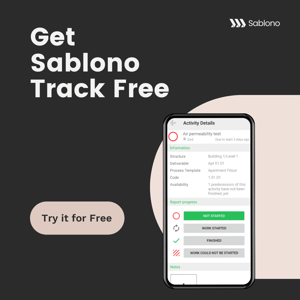A software solution like Sablono, which allows you to track progress of your deliverables on an unprecedented level of detail, tends to increase the transparency of your project drastically. Setting up standardized processes, which include all activities performed on each deliverable (e.g. apartment), planned duration, labour force and responsible contractor, and tracking construction progress for each deliverable (e.g. apartment) against those processes will make information quickly accessible to everyone involved in the project.
Transparency is a valuable asset to most, if not all, players in the construction industry, because it helps you understand what is the real issue and will expedite the mitigation process. While I think everybody understands this value, potential clients we talk to are sometimes still afraid to implement such a high level of transparency in their project. They don’t want everybody involved in the project to know everything. Especially, they don’t want others to know what exactly their company is doing and how well – or poor – they are really performing.
Nowadays, this reluctance to share information can be found on each hierarchy level of most projects being executed in the AEC industry. Traits and (sub-)contractors don’t want to share information freely with the project management, because instead of facing potential issues, they rather keep it quiet and resolve them on their own. Their main fear is upper management making a big deal out of it and potentially withhold payment, which really only happens on a very small fraction of the time. Even though project management usually is quick in demanding transparency of their (sub-)contractors, they usually behave the same way towards the project owner. You could easily split this into a lot more levels of hierarchy – worker to foreman, foreman to site supervisor, etc. – but I claim you would find the same mechanism working on all those levels: The lower level does not want to provide the full picture to their higher level since they rather want to try and fix potential situations on their own than risk losing contracts, payment and ultimately jobs.
While this might be understandable, we at Sablono strongly believe that this way of thinking does neither keep the big “project-delivery-goal” in mind nor will it help face the future challenges the AEC industry is heading to. In reality, most of the time wasted is due to minor issues that were not reported in a timely manner or have not been accessible to the right person at the right time. There are tons of projects where one might see that working like this does not necessarily fuel a timely execution – One of the most prominent examples in Germany is the new BER-airport in Berlin. I know, the BER is a complex and controversial topic, but it can serve as a perfect example of a construction project where construction issues were not addressed correctly. As a result, we now have a significantly delayed major project and losses in the millions. I think it is fair to say that, back in 2012, one of the main problems was the reporting from one hierarchy level to the next being often inaccurate, sometimes even sugar-coated. The fact that the BER was and still is a political issue, lead to the last-minute postponing of the planned opening date – which then turned into numerous other problems (additional delays; low quality of work) that even today still need to be solved by the current project team.
My bottom line is this: I understand that it might be frightening to share your team’s progress regularly, daily, or even hourly with every project partner including your superiors. But imagine the benefits you and everybody, on every hierarchy level, would be experiencing. Imagine you would not have to painfully search for required information to do your job, but would instead have it at your fingertips whenever you need it. As a (sub-)contractor, you would always know exactly when your work was required, since your predecessor quickly reports once he is finished working on a deliverable. As a project manager, you would not have to rely on false or sugar-coated information any more, but instead could take actions on the solid ground of real-time progress and quality data. And as a project owner, you could understand potential risks and opportunities of your complete project portfolio based on aggregated plan vs. actual analysis on one single platform. Shouldn’t those pros by far outweigh potential cons? I personally think it’s about time to stop being afraid and start seeing opportunities rather than problems – on every hierarchy level.
We at Sablono work for a more transparent future in which everybody has all the information he needs to perform his duties, whenever he needs it.


